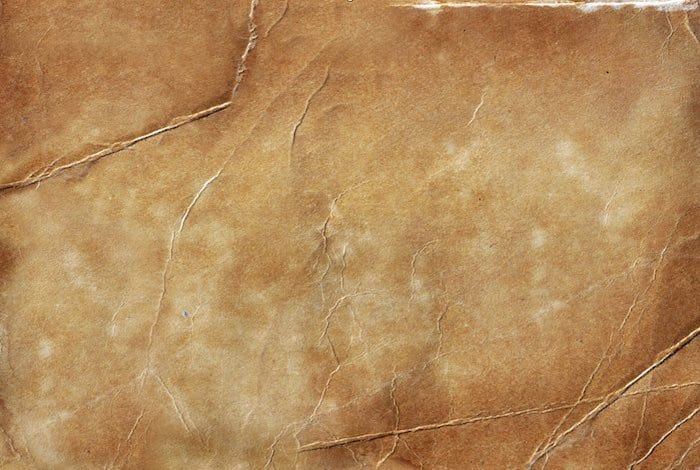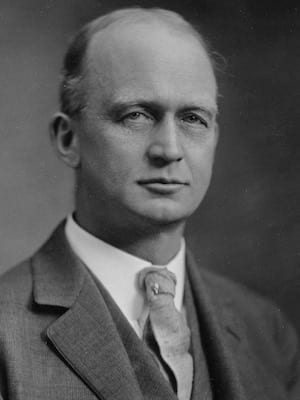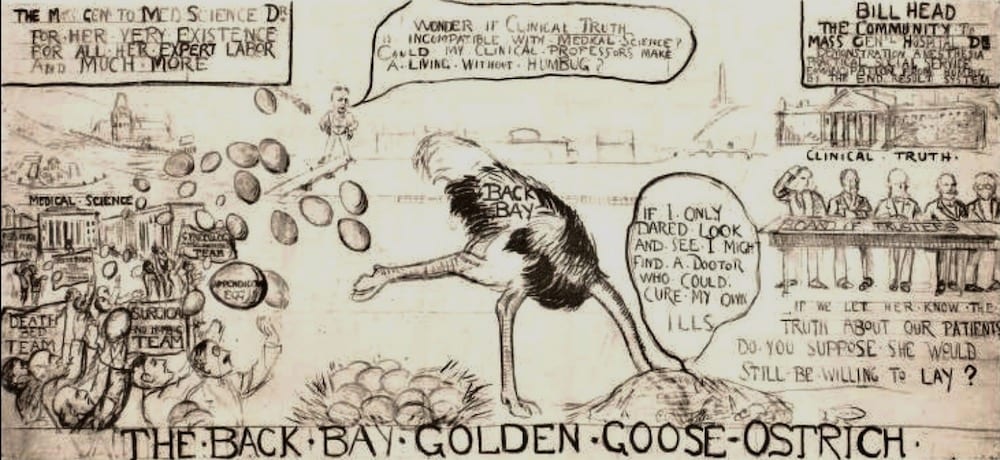Ernest Amory Codman
Ernest Amory Codman (1869 – 1940) was an American surgeon.
Founder of an ‘end results system‘ to track the outcomes of patient treatments. Codman believed that this information should be made public so that patients could be guided in their choices of physicians and hospitals.
Codman helped in the founding of the American College of Surgeons and its Hospital Standardization Program [The Joint Commission]
Extensive work on skiagrams, x-rays and the shoulder joint, in particular the subacromial bursa and rotator cuff injuries. Special interest in the shoulder, in particular the subacromial bursa. Traveled to Vienna as a third year medical student and learned about the subacromial bursa and its bursitis. He pursued the subject exhaustively, attracting attention to this condition; described a test for rotator cuff insufficiency (Codman test) and rehabilitation exercises (Codman exercises) in his book The shoulder in 1934
Biography
- Born 30 December 1869 Boston, Massachusetts
- 1887-1895 – Medical degree, Harvard Medical School with his best friend Harvey Cushing (1869-1939)
- 1895 – Assistant in Anatomy at Massachusetts General Hospital (MGH)
- 1899 – First ‘skiagrapher‘ (radiologist) at Boston Children’s Hospital.
- 1900 – Assistant in clinical operative surgery, MGH
- 1903 – Founding member of the American Society of Clinical Surgery (now the Society of Clinical Surgery)
- 1910 – Devised the ‘end result system of standardization,’ and suggested that hospitals track patient care outcomes for all patients admitted. Successful outcomes would indicate treatments should be repeated for similar cases, whereas failures would reveal a need for a different treatment regimen.
- 1911 – Somewhat of a polemic chap, Codman resigned from MGH and set up his own 20-bed hospital – the Codman hospital – where he meticulously collected outcomes data on all his patients; published his findings in his hospital’s report, and encouraged the professional community to do the same. Codman even gave his report to prospective patients without expressing fear of the consequences of his actions
- 1917 – On December 7, the day after the munitions ship explosion in Halifax, Nova Scotia, which killed 3,000 and injured 20,000 people, Codman closed his hospital and left to help care for victims
- 1920 – Developed the first national registry. The National Register for bone sarcoma.
- 1924 – Unable to gain accurate data for the Registry, Codman devised specific 25-point diagnostic criteria which included clinical, radiographic, and histologic factors.
- Died 23 November 1940, Boston
Medical Eponyms
Codman triangle – radiological sign (1926)
Type of periosteal reaction most often associated with aggressive bone lesions. A localized, triangular ridge of new bone is formed where periosteum is elevated in rapidly growing bone processes, such as neoplasms, particularly osteosarcoma and osteomyelitis. An isolated cuff (triangle) of reactive subperiosteal new bone at the boundary of any benign or malignant mass that rapidly elevates the periosteum. Part of Codman 25-point diagnostic criteria of bone sarcoma:
The little cuff of reactive bone of trumpet shape which surrounds the upper limit of the tumor appears in the X-ray as a triangular space on each side of the shaft under the uplifted periosteal edge
Codman 1926
Codman test (1934)
Codman sign or Drop arm test is used in the assessment of a suspected rotator cuff tear. Patient seated, the examiner passively abducts the patients arms to 120 degrees. The patient is asked to hold the arm in this position without support and slowly allow it to return to neutral. Weakness, inability to hold or a sudden ‘drop’ of the arm implies weakness or injury to supraspinatus.
Codman classification of distal radius fractures (1900)
In 1900, Codman was the first to correlate Colles’ 1814 description with x-ray appearances of the fracture. He divided distal radius fractures into ten (X) Classes. The ‘typical Colles fracture – Class VIII’ occurred in 46% of the 140 x-rays examined. [BMSJ 1900; 305-308] The paper describes and demonstrates:
- Class I (Base styloid process of radius);
- Class II (Inner angle of distal radius);
- Class III (Transverse fracture distal to epiphyseal line);
- Class IV (Salter-Harris III);
- Class V (Salter-Harris I);
- Class VI (Salter-Harris II);
- Class VII (Salter-Harris V);
- Class VIII (typical Colles fracture);
- Class IX (stellate fracture with longitudinal fissures);
- Class X (‘reversed Colles fracture’ though looks more like a Barton fracture than a Smith fracture…)
Other Eponyms
- Codman tumour (1931) – Epiphyseal chondromatous giant cell tumors of the upper end of the humerus. [Surgery, Gynecology and Obstetrics. 1931;52:543-548]
- Codman exercises (1934) – Swinging or Pendulum Exercises; gentle swinging motion of upper limbs after a shoulder injury to reduce pain and mobilize the shoulder joint.
- Codman paradox (1934) – paradoxically not a paradox but merely a mechanical phenomenon which permits the replacement of a single 90° rotation around a longitudinal axis by three orthogonal and successive rotations.
Controversies
Codman belonged to the so called Boston Brahmins, one of the First Families of Boston descendants from the English Protestants who founded the city and settled New England
- 1914 – Codman lost his staff privileges when the hospital (Massachusetts General Hospital) refused to institute his plan for evaluating the competence of surgeons
- 1915 – Ostracized and ordered by his colleagues. Requested to step down as chair of the local surgical society for public insult after presenting a cartoon at a society meeting portraying greedy surgeons grasping for gold from wealthy patients (shown as an ostrich with its head buried in Boston’s prosperous Beacon Hill).
- 1915 – His idea was taken up by the Committee on Hospital Standardization and the Society of Clinical Surgery and involved him as a founding member of the American College of Surgeons.
Notable Quotables
Perhaps I have sacrificed my success as a distinguished surgeon to these pursuits (hunting and fishing). I have loved them better than teaching dozing medical students, the pride of amphitheatre dexterity, or the hushed dignity of the consultant at the bedside of important persons. On many a bright October day I have been glad that my talents as a teacher were not in demand. In the spring when I dig up the first worm in my garden, I say with Hambone: ‘That old red worm he look up in my face and say, Whar yo’ fishing pole?‘ Then I get my regard for not being an overworked Chief of the Surgical Service. In summer as I drift about on some out-of-way pond in my portable boat, watching the cotton wool in the clouds, and momentarily expecting a strike from ‘a big one,’ I am grateful I am not in demand at the bankers’ bedsides.
Codman, 1934: XXXiX
The common sense notion that every hospital should follow every patient it treats, long enough to determine whether or not the treatment has been successful, and then to inquire, ‘If not, why not?’ with a view to preventing similar failures in the future
Codman, 1911
Major Publications
- Codman EA. A Study in Hospital Efficiency: As Demonstrated by the Case Report of the First Five Years of a Private Hospital. Boston: Thomas Todd Co.; 1918: 4–10,108,162. [Reprint: Clin Orthop Relat Res 2013;471:1778–1783]
- Codman EA. The registry of bone sarcoma as an example of the end-result idea in hospital organization. Bull Am Coll Surg. 1924;8:34–38. [Reprint: Clin Orthop Relat Res 2009;467:2766–2770]
- Codman EA. Bone sarcoma: an interpretation of the nomenclature used by the Committee on the Registry of Bone Sarcoma of the American College of Surgeons. New York: Paul B. Hoeber. 1925
- Codman EA. Registry of bone sarcoma; part I, twenty-five criteria for establishing diagnosis of osteogenic sarcoma; part II, 13 registered cases of 5 year cures analyzed according to these criteria. Surg Gynecol Obstet. 1926;42:381–393. [Reprint: Clin Orthop Relat Res 2009;467:2771–2782]
- Codman EA. Epiphyseal chondromatous giant cell tumors of the upper end of the humerus. Surgery, Gynecology and Obstetrics. 1931;52:543-548. [Reprinted: Clin Orthop Relat Res. 1980;(153):7-13.] [Codman tumour]
- Codman EA. The shoulder: rupture of the supraspinatus tendon and other lesions in or about the subacromial bursa. 1934. [Codman test] [Codman Exercises]
- Codman EA. Autobiographical preface. In The Shoulder. Private printing. 1934:5-40
- Codman EA. Codman paradox of shoulder movement. In The Shoulder. Private printing. 1934:42-46
References
- Mulley AG. E.A. Codman and the Rhetoric of Battle: A Commentary. The Milbank Quarterly. 1898;67(2):262-267
- Mulley AG. E.A. Codman and the End Results Idea: A Commentary. The Milbank Quarterly. 1898;67(2):257–261
- Kaska SC, Weinstein JN. Historical perspective. Ernest Amory Codman, 1869-1940. A pioneer of evidence-based medicine: the end result idea. Spine (Phila Pa 1976). 1998 Mar 1;23(5):629-33.
- Politti JC, Goroso G, Valentinuzzi ME, Bravo O. Codman’s paradox of the arm rotations is not a paradox: mathematical validation. Med Eng Phys. 1998 Jun;20(4):257-60. [Codman paradox]
- Shel CM, Dunlap KD. Florence Nightingale, Dr. Ernest Codman, American College of Surgeons Hospital Standardization Committee, and The Joint Commission: Four Pillars in the Foundation of Patient Safety. Perioperative Nursing Clinics. 1998;3(1):19-26
- Mallon WJ. Ernest Amory Codman: The End Result of a Life in Medicine. W.B. Saunders. 2000
- Neuhauser D. Ernest Amory Codman MD. Qual Saf Health Care 2002;11:104–105
- Stepan V, Otahal S. Is Codman’s paradox really a paradox? J Biomech. 2006;39(16):3080-2 [Codman paradox]
- Brand RA. Ernest Amory Codman, MD, 1869–1940. Clin Orthop Relat Res. 2009; 467(11): 2763–2765
- Brand RA. Biographical sketch: Ernest Amory Codman, MD (1869-1940). Clin Orthop Relat Res. 2013; 471(6): 1775-7.
- Hicks CW. A prophet to modern medicine: Ernest Amory Codman. BMJ 2013;347:f7368

eponym
the person behind the name



